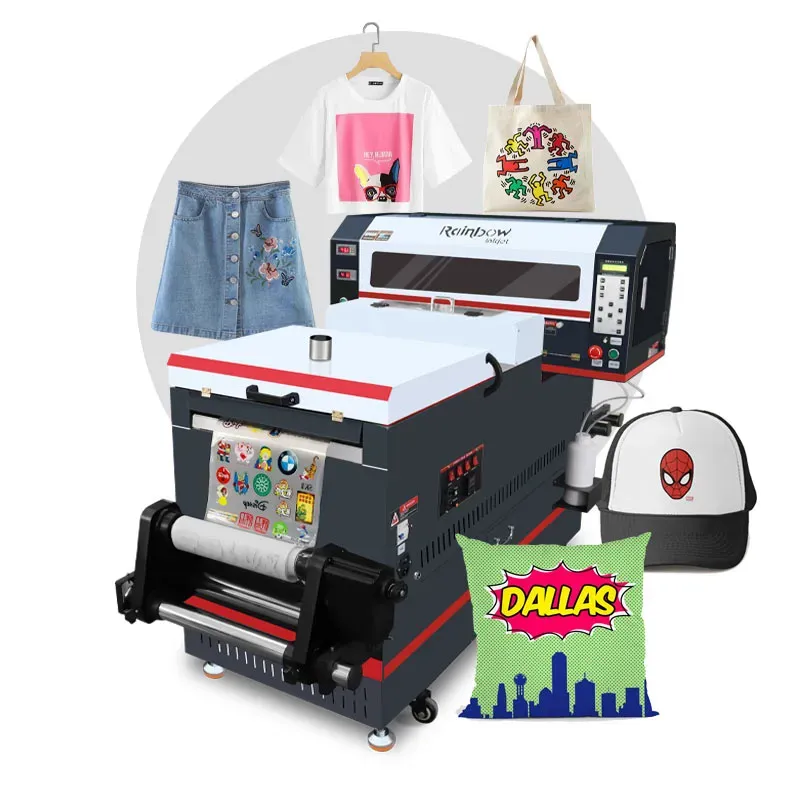
If you’re eager to explore the cutting-edge realm of textile printing, understanding DTF printing equipment is crucial for a successful start. Direct-to-Film (DTF) printing has emerged as a popular choice among both novices and seasoned professionals due to its impressive versatility and high-quality results. A comprehensive understanding of the essential tools, such as a DTF printer, heat press for DTF, and high-quality DTF transfer film, is vital to harness the full potential of this innovative printing method. Moreover, knowledge of DTF inks and their specific applications can greatly improve the vibrancy and durability of your printed designs. This guide aims to equip you with everything you need to know about DTF printing, providing insights into necessary equipment, industry standards, and key considerations for beginners.
Embarking on your journey into textile printing with DTF technology requires familiarity with certain specialized equipment designed to enhance your printing capabilities. Known as Direct-to-Film (DTF) printing, this technique employs unique tools and processes that distinguish it from traditional methods. Integral to this setup are devices like the DTF printer, which operates with specific formulations of DTF inks, and the heat press, a significant element in ensuring effective design transfer. The use of high-quality DTF transfer film and the proper application of adhesive powder also play critical roles in achieving optimal results. As you delve into this dynamic field, understanding these elements will be essential for producing eye-catching and durable designs.
What is DTF Printing?
DTF printing, short for Direct-to-Film printing, is a revolutionary technique that transports vibrant ink directly from a specially coated film onto fabric using a heat transfer process. This method stands out for its ability to create intricate designs with remarkable color accuracy, making it a favored choice among textile printers. To understand the full potential of DTF printing, one must first grasp its operational mechanics, including how films, inks, and heat presses work in harmony to deliver high-quality prints.
The versatility of DTF printing allows for a broad range of fabrics, from cotton to polyester, ensuring that businesses can cater to various client needs. The process involves printing a design onto film, applying a layer of adhesive powder, and using a heat press to firmly embed the ink into the fabric. This technique not only enhances durability but also provides a soft feel, distinguishing it from traditional screen printing.
Essential DTF Printing Equipment
To embark on your DTF printing journey, specific equipment is crucial for achieving optimal results. The first piece of equipment you will need is a reliable DTF printer, which is specifically designed to handle the unique requirements of printing on DTF transfer films. These printers utilize special water-based inks that deliver vibrant colors and excellent durability, key factors for any successful printing operation.
In addition to a top-notch DTF printer, having a quality heat press is equally important. This machine not only applies heat to transfer prints from the film to fabric but also ensures that the temperature and pressure are uniform, which is essential for producing consistent, professional-quality prints. Various models are available to accommodate different production levels, but investing in a reliable heat press is a cornerstone of any effective DTF printing setup.
Choosing the Right DTF Transfer Film
Selecting the appropriate DTF transfer film is vital for achieving crisp, vibrant prints. Not all films are created equal; high-quality DTF transfer films are specifically engineered to provide excellent ink adherence and transferability onto fabrics. When choosing a film, look for brands with a proven track record, and consider factors like coating type, transparency, and compatibility with your printer and inks.
Moreover, the DTF transfer film you select should complement the specific inks used in your printing process. This harmony between film and ink is crucial for ensuring that colors remain true and vibrant after the transfer is completed. Testing different films and understanding their interaction with your chosen DTF inks is an essential part of refining your printing techniques.
Understanding DTF Inks and Their Importance
DTF inks play a critical role in the quality and longevity of your prints. Unlike traditional printing inks, DTF inks are specially formulated to adhere well to both the DTF transfer film and the fabric surface, ensuring a strong bond that withstands washing and wear over time. Choosing the right inks is essential to avoid problems such as fading colors or poor adhesion.
When selecting DTF inks, prioritize those that have been specifically designed for this printing method, as they provide superior vibrancy and durability. Investing in high-quality DTF inks not only enhances your print quality but also can save costs associated with errors and reprints, ultimately improving the profitability of your operations.
Setting Up Your DTF Printing Workspace
Creating an efficient workspace for DTF printing is crucial for optimizing productivity. Start by organizing your DTF printer and heat press in a well-ventilated area to ensure safe operations, especially when working with heated equipment. Additionally, designating spaces for your materials—transfer films, adhesive powders, DTF inks, and finished products—can streamline your workflow and reduce time spent looking for supplies.
Furthermore, consider investing in storage solutions that help keep your equipment safe and accessible. A well-organized workspace not only enhances efficiency but also improves the overall printing experience, allowing you to focus on creative aspects rather than logistics.
Training and Education for Successful DTF Printing
As with any craft, successful DTF printing relies on continuous learning and practice. Familiarizing yourself with the machinery, materials, and techniques will significantly boost your confidence and competence in this field. Seek out online tutorials, industry webinars, or even hands-on training sessions provided by equipment suppliers to bolster your knowledge.
By engaging with educational resources, you will stay informed of the latest advancements in DTF technology, helping you adapt to evolving market trends and consumer preferences. Mastery in DTF printing hinges on understanding the intricacies of your equipment and the methods in which you can optimize them for superior results.
Frequently Asked Questions
What equipment do I need for DTF (Direct-to-Film) printing?
To start with DTF printing, you’ll need several key pieces of equipment including a DTF printer specifically designed for printing on transfer film, quality heat press for DTF to transfer designs onto fabric, high-quality DTF transfer film, adhesive powder for proper ink adhesion, and specialized DTF inks to ensure vibrant colors and durability.
How does a heat press work in DTF printing?
In DTF printing, a heat press is used to apply heat and pressure to transfer designs from DTF transfer film onto fabrics. For best results, choose a heat press that provides consistent temperature and pressure to ensure that the transfer is successful and durable.
What makes DTF inks different from traditional printing inks?
DTF inks are specially formulated for Direct-to-Film printing, offering enhanced color vibrancy and durability compared to traditional inks. These inks are designed for better adhesion to fabrics and to withstand washing without fading or peeling.
Can I use any transfer film for DTF printing?
No, it’s essential to use high-quality transfer films that are specifically designed for DTF printing. These films ensure proper adhesion of the ink and contribute to the overall quality of your final prints.
What is the role of adhesive powder in DTF printing?
Adhesive powder is a crucial component in DTF printing. It is applied to wet ink on the DTF transfer film to create a bond between the ink and the fabric during the heat transfer process. Proper application and curing of the adhesive powder ensure the longevity and quality of the print.
How much does DTF printing equipment cost?
The cost of DTF printing equipment can vary widely. Entry-level setups may start at a few thousand dollars, including DTF printers, heat presses, and other necessary supplies. Professional-grade equipment can be considerably more expensive, so it’s important to align your budget with your business expectations.
| Key Equipment | Description |
|---|---|
| DTF Printer | The primary machine designed specifically to print on transfer film with specialized inks. |
| Heat Press | Used to transfer designs from DTF film to fabric using heat and pressure. |
| Transfer Film | High-quality films that ensure effective ink adhesion and vibrant color output. |
| Adhesive Powder | A specialized powder that ensures proper ink adhesion when applied to wet ink. |
| DTF Inks | Specially formulated inks that enhance color vibrancy and durability. |
Summary
DTF printing equipment is essential for anyone looking to embark on the journey of textile printing. This innovative printing method utilizes advanced machinery including DTF printers, heat presses, transfer films, adhesive powders, and specially formulated DTF inks, each playing a crucial role in achieving high-quality prints. Understanding and investing in the right DTF printing equipment is key to success in this growing industry. Keep abreast of emerging technologies and market trends to stay competitive and meet consumer demands effectively.




